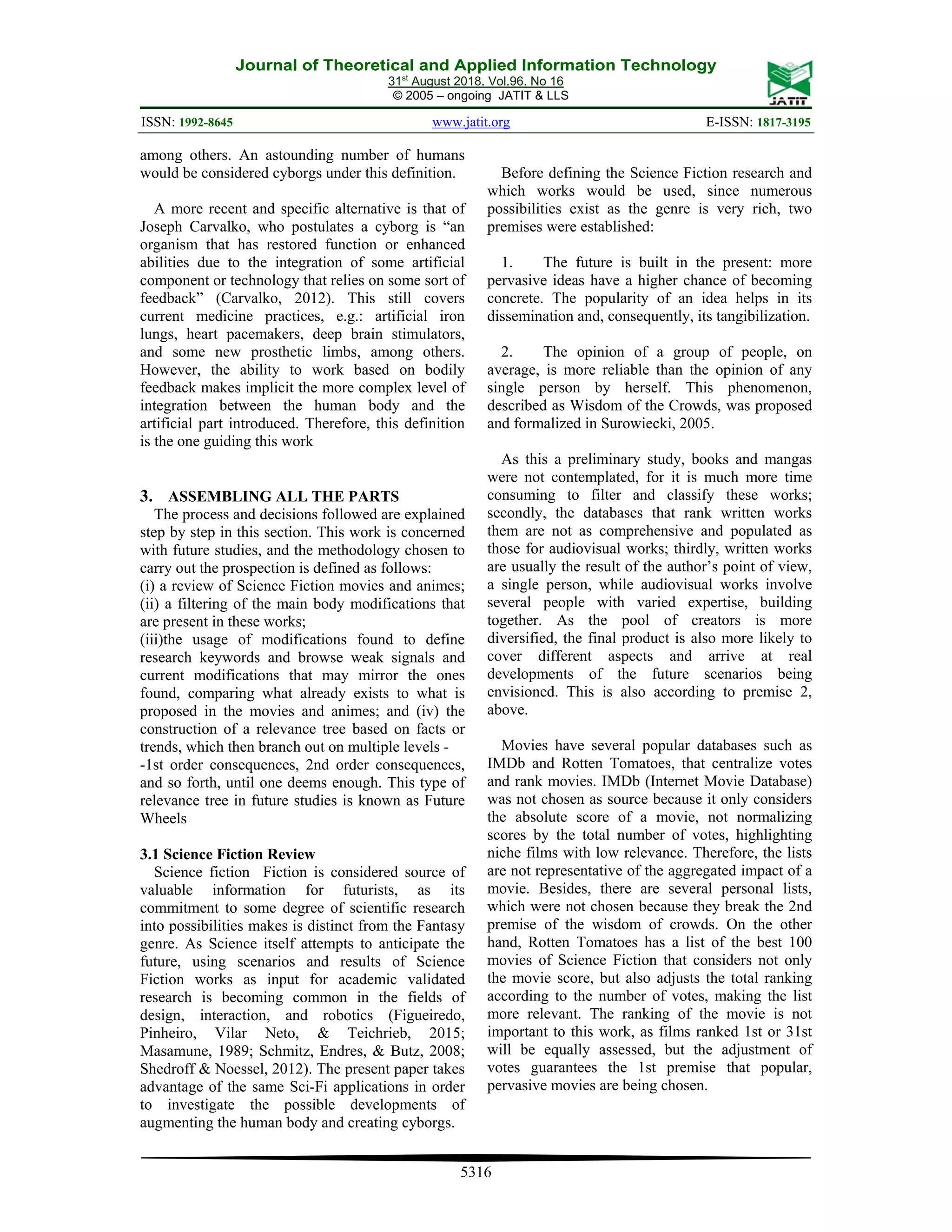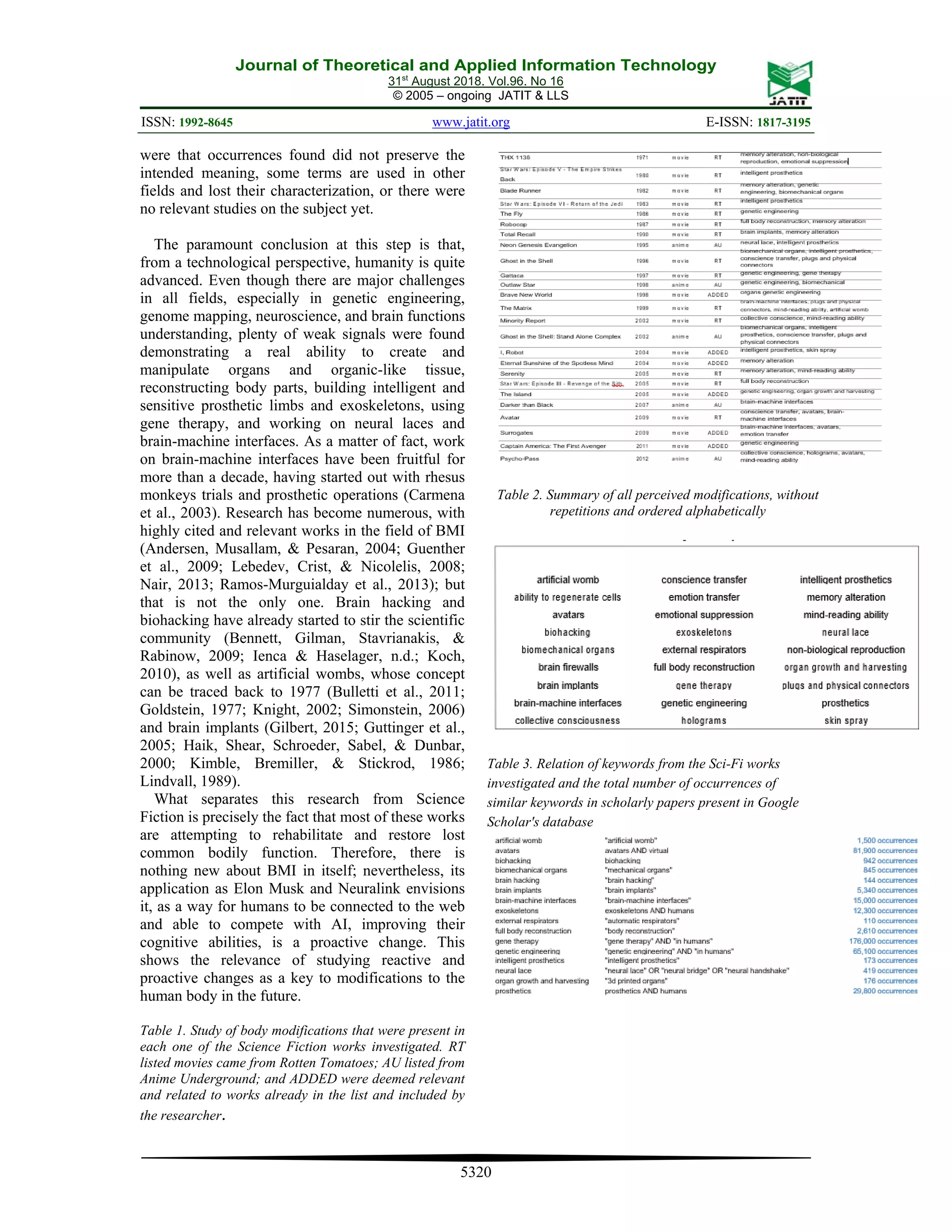The study explores the influence of science fiction on concepts of human body modifications, categorizing changes into genetic engineering, biomechanical enhancements, software integration, and virtual avatars. By reviewing films and anime, the research aims to identify real scientific advancements paralleling these fictional scenarios and assess potential societal implications. The ethical debate surrounding what defines humanity in the context of cyborgs and modifications is acknowledged but not deeply analyzed.










![Journal of Theoretical and Applied Information Technology
31st
August 2018. Vol.96. No 16
© 2005 – ongoing JATIT & LLS
ISSN: 1992-8645 www.jatit.org E-ISSN: 1817-3195
5324
REFRENCES:
[1] America, P., Rommes, E., & Obbink, H. (2004).
Multi-view Variation Modeling for Scenario
Analysis (pp. 44–65). Springer, Berlin,
Heidelberg. https://doi.org/10.1007/978-3-540-
24667-1_5
[2] Andersen, R. A., Musallam, S., & Pesaran, B.
(2004). Selecting the signals for a brain–
machine interface. Current Opinion in
Neurobiology,14(6),720–726.
https://doi.org/10.1016/J.CONB.2004.10.005
[3] Astor, M. (2017, July 25). Microchip Implants
for Employees? One Company Says Yes. The
New York Times. Retrieved from
https://www.nytimes.com/2017/07/25/technolog
y/microchips-wisconsin-company-
employees.html
[4] Banks, I. M. (1987). Consider Phlebas.
(MacMillan, Ed.).
[5] Bennett, G., Gilman, N., Stavrianakis, A., &
Rabinow, P. (2009). From synthetic biology
to biohacking: are we prepared? Nature
Biotechnology, 27(12), 1109–1111.
https://doi.org/10.1038/nbt1209-1109
[6] Blascovich, J., Loomis, J., Beall, A. C., Swinth,
K. R., Hoyt, C. L., & Bailenson, J. N. (2002).
Immersive Virtual Environment Technology as
a Methodological Tool for Social Psychology.
Psychological Inquiry, 13(2), 103–124.
https://doi.org/10.1207/S15327965PLI1302_01
[7] Blomkamp, N. (2013). Elysium.
[8] Bulletti, C., Palagiano, A., Pace, C., Cerni, A.,
Borini, A., & de Ziegler, D. (2011). The
artificial womb. Annals of the New York
Academy of Sciences, 1221(1), 124–128.
https://doi.org/10.1111/j.1749-
6632.2011.05999.x
[9] Carmena, J. M., Lebedev, M. A., Crist, R. E.,
O’Doherty, J. E., Santucci, D. M., Dimitrov, D.
F.,Nicolelis, M. A. L. (2003). Learning to
Control a Brain–Machine Interface for
Reaching and Grasping by Primates. PLoS
Biology, 1(2), e42.
https://doi.org/10.1371/journal.pbio.0000042
[10]Carvalko, J. (2012). The Techno-human Shell-
A Jump in the Evolutionary Gap. Sunbury
Press.
[11]Clynes, M., & Kline, N. (1960). Cyborgs and
space. Astronautics, (September), 26–27, 74–
75.
[12]Dvorsky, G. (2017). The Most Futuristic
Predictions That Came True in 2017. Retrieved
from https://gizmodo.com/the-most-futuristic-
predictions-that-came-true-in-2017-
1821226186/amp
[13]Figueiredo, L. S., Pinheiro, M. G. M., Vilar
Neto, E. X. C., & Teichrieb, V. (2015). An open
catalog of hand gestures from Sci-Fi movies.
Conference on Human Factors in Computing
Systems - Proceedings, 18, 1319–1324.
https://doi.org/10.1145/2702613.2732888
[14]Garland, E. (2016). How to use STEEP trend
analysis for business strategy. Medium.
Retrieved from
https://medium.com/@ericgarland/how-to-use-
steep-trend-analysis-for-business-strategy-
52e3656b17f9
[15]Gilbert, F. (2015). A Threat to Autonomy? The
Intrusion of Predictive Brain Implants. AJOB
Neuroscience, 6(4), 4–11.
https://doi.org/10.1080/21507740.2015.107608
7
[16]Glenn, J. C. (1972). Futurizing Teaching vs
Futures Course. Social Science Record, 9(3).
[17]Goldstein, M. A. (1977). Choice Rights and
Abortion: The Begetting Choice Right and State
Obstacles to Choice in Light of Artificial Womb
Technology. Southern California Law Review,
51. Retrieved from
http://heinonline.org/HOL/Page?handle=hein.jo
urnals/scal51&id=893&div=&collection=
[18]Gondry, M. (2004). Eternal Sunshine of the
Spotless Mind.
[19]Guenther, F. H., Brumberg, J. S., Wright, E. J.,
Nieto-Castanon, A., Tourville, J. A., Panko, M.,
Kennedy, P. R. (2009). A Wireless Brain-
Machine Interface for Real-Time Speech
Synthesis. PLoS ONE, 4(12), e8218.
https://doi.org/10.1371/journal.pone.0008218
[20]Guttinger, M., Fedele, D., Koch, P., Padrun, V.,
Pralong, W. F., Brustle, O., & Boison, D.
(2005). Suppression of Kindled Seizures by
Paracrine Adenosine Release from Stem Cell-
Derived Brain Implants. Epilepsia, 46(8), 1162–
1169. https://doi.org/10.1111/j.1528-
1167.2005.61804.x
[21]Haik, K. L., Shear, D. A., Schroeder, U., Sabel,
B. A., & Dunbar, G. L. (2000). Quinolinic Acid
Released from Polymeric Brain Implants
Causes Behavioral and Neuroanatomical
Alterations in a Rodent Model of Huntington’s
Disease. Experimental Neurology, 163(2), 430–
439. https://doi.org/10.1006/EXNR.2000.7384
[22]Hongo, M. (1998). Outlaw Star.](https://image.slidesharecdn.com/finalpublishedpaper-180904034116/75/FUTURE-OF-MODIFICATIONS-ON-THE-HUMAN-BODY-ACCORDING-TO-SCIENCE-FICTION-WETWARE-AND-THE-CYBORG-ERA-11-2048.jpg)
![Journal of Theoretical and Applied Information Technology
31st
August 2018. Vol.96. No 16
© 2005 – ongoing JATIT & LLS
ISSN: 1992-8645 www.jatit.org E-ISSN: 1817-3195
5325
[23]Ienca, M., & Haselager, P. (n.d.). Hacking the
brain: brain–computer interfacing technology
and the ethics of neurosecurity. Ethics and
Information Technology, 18.
https://doi.org/10.1007/s10676-016-9398-9
[24]Kamiyama, K. (2002). Ghost in the Shell: Stand
Alone Complex.
[25]Kershner, I. (1980). Star Wars: Episode V - The
Empire Strikes Back.
[26]Kimble, D. P., Bremiller, R., & Stickrod, G.
(1986). Fetal brain implants improve maze
performance in hippocampal-lesioned rats.
Brain Research, 363(2), 358–363.
https://doi.org/10.1016/0006-8993(86)91023-1
[27]Knight, J. (2002). Artificial wombs: An out of
body experience. Nature, 419(6903), 106–107.
https://doi.org/10.1038/419106a
[28]Koch, C. (2010). A smart vision of brain
hacking. Nature, 467(7311), 32–32.
https://doi.org/10.1038/467032b
[29]Krassenstein, B. (2015). 11 Companies Leading
the 3D Bioprinting Space |. Retrieved December
18, 2017, from https://3dprint.com/88792/3d-
bioprinting-companies/
[30]Lebedev, M. A., Crist, R. E., & Nicolelis, M. A.
L. (2008). Building Brain–Machine Interfaces
to Restore Neurological Functions. Methods for
Neural Ensemble Recordings. Retrieved from
http://www.ncbi.nlm.nih.gov/pubmed/21204440
[31]Libman, L., & Williams, L. (1998). Brave New
World.
[32]Lindvall, O. (1989). Transplantation into the
human brain: present status and future
possibilities. Journal of Neurology,
Neurosurgery, and Psychiatry, Suppl(Suppl),
39–54. Retrieved from
http://www.ncbi.nlm.nih.gov/pubmed/2666578
[33]Lucas, G. (2002). Star Wars: Episode II –
Attack of the Clones.
[34]Mark Phillips. (2012). “Blade Runner”s’
artificial legs controversial at Olympics.
CBS News.Retrieved from
https://www.youtube.com/watch?v=lSGBwUEc
M6c
[35]Martins, A., & Rincon, P. (2014). Paraplegic in
robotic suit kicks off World Cup. BBC News.
Retrieved from
http://www.bbc.com/news/science-
environment-27812218
[36]Masamune, S. (1989). Ghost in the Shell.
(Kodansha, Ed.).
[37]McCormick, R. (2015, June 30). Mark
Zuckerberg says we’ll be able to send emotions
to each other soon. The Verge. Retrieved from
https://www.theverge.com/platform/amp/2015/6
/30/8873819/mark-zuckerberg-facebook-
sending-emotions-soon
[38]. McCreery, M. P., Kathleen Krach, S.,
Schrader, P. G., & Boone, R. (2012). Defining
the virtual self: Personality, behavior, and the
psychology of embodiment. Computers in
Human Behavior, 28(3), 976– 983.
https://doi.org/10.1016/J.CHB.2011.12.019
[39]Miller, G. (2015). Mad Max: Fury Road.
[40]Nair, P. (2013). Brain-machine interface.
Proceedings of the National Academy of
Sciences of the United States of America,
110(46), 18343.
https://doi.org/10.1073/pnas.1319310110
[41]National Institute of Neurological Disorders and
Stroke. (n.d.). Deep Brain Stimulation for
Parkinson’s Disease Information Page |
National Institute of Neurological Disorders and
Stroke. Retrieved December 20, 2017, from
https://www.ninds.nih.gov/Disorders/All-
Disorders/Deep-Brain-Stimulation-Parkinsons-
Disease-Information-Page
[42]Newitz, A. (2017, March 27). Elon Musk is
setting up a company that will link brains and
computers |Ars Technica. Ars Technica.
Retrieved from
https://arstechnica.com/information-
technology/2017/03/elon-musk-is-setting-up-a-
company-that-will-link-brains-and-computers/
[43]Niccol, A. (1997). Gattaca.
[44]Okamura, T. (2007). Darker than Black.
[45]Padilha, J. (2014). RoboCop.
[46]Park, J. H., Chung, S. J., Lee, C. S., & Jeon, S.
R. (2011). Analysis of hemorrhagic risk factors
during deep brain stimulation surgery for
movement disorders: comparison of the
circumferential paired and multiple electrode
insertion methods. Acta Neurochirurgica,
153(8), 1573–1578.
https://doi.org/10.1007/s00701-011-0997-2
[47]Proyas, A. (2004). I, Robot.
[48]Ramos-Murguialday, A., Broetz, D., Rea, M.,
Läer, L., Yilmaz, Ö., Brasil, F. L., …
Birbaumer, N. (2013). Brain-machine interface
in chronic stroke rehabilitation: A controlled
study. Annals of Neurology, 74(1), 100–108.
https://doi.org/10.1002/ana.23879](https://image.slidesharecdn.com/finalpublishedpaper-180904034116/75/FUTURE-OF-MODIFICATIONS-ON-THE-HUMAN-BODY-ACCORDING-TO-SCIENCE-FICTION-WETWARE-AND-THE-CYBORG-ERA-12-2048.jpg)
![Journal of Theoretical and Applied Information Technology
31st
August 2018. Vol.96. No 16
© 2005 – ongoing JATIT & LLS
ISSN: 1992-8645 www.jatit.org E-ISSN: 1817-3195
5326
[49]Sanders, R. (2016). Ghost in the Shell.
[50]Schmitz, M., Endres, C., & Butz, A. (2008). A
Survey of Human-Computer Interaction Design
in Science Fiction Movies. Proceedings of the
2nd International Conference on INtelligent
TEchnologies for Interactive enterTAINment,
1–10.
https://doi.org/10.4108/ICST.INTETAIN2008.2
476
[51]Scott, R. (1982). Blade Runner.
[52]Shedroff, N., & Noessel, C. (2012). Make It So:
Interaction Design Lessons from Science
Fiction. Rosenfeld Media.
.](https://image.slidesharecdn.com/finalpublishedpaper-180904034116/75/FUTURE-OF-MODIFICATIONS-ON-THE-HUMAN-BODY-ACCORDING-TO-SCIENCE-FICTION-WETWARE-AND-THE-CYBORG-ERA-13-2048.jpg)